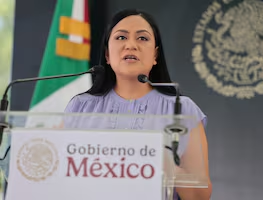Más Información

INE aprueba ampliación presupuestal de 9.2 mdp; se destinará para comprar chalecos en elecciones del Poder Judicial

Sheinbaum anuncia obras de infraestructura en Nayarit; destaca puente que irá de Bahía de Banderas a Puerto Vallarta y un acueducto

Detienen a presunto jefe de célula delictiva allegada a Los Chapitos; se encargaba de narcomenudeo y compra-venta de armamento

“¡Arráncate, Coalcomán!”; así fue la campaña de Anavel Ávila, presuntamente ligada al “Mencho”, para Movimiento Ciudadano

Presupuesto para programas sociales está asegurado en la Constitución: Ariadna Montiel; destaca que se benefician a 320 mil nayaritas

Sheinbaum anuncia construcción de Farmacias del Bienestar en 2025; asegura habrá medicamentos gratuitos para personas vulnerables
The Mexican-American War , also known as the U.S. intervention in Mexico, was an armed conflict between the two North American countries that took place from 1846 to 1848.
The conflict arose from the U.S. annexation of Texas in 1845 after a treaty signed by Mexican General Antonio López de Santa Anna when he was held prisoner by the Texan Army. U.S. President James K. Polk advocated for land expansion, whether by peaceful means or by armed forces. The U.S. annexation of Texas was a provocation for the Mexican government, but Polk went further and sent his troops to Mexico, along with a diplomatic mission to negotiate the sale of territory. Nevertheless, the U.S. troops’ presence was another provocation designed to lead Mexico into starting the armed conflict and allowing Polk to declare war after Mexican forces attacked U.S. forces.
The Battle of Churubusco took place in this context on August 20, 1847, while Santa Anna’s army was in retreat from the Batlle of Contreras, also known as the Battle of Padierna. That battle, that took place from August 19 to 20, 1847, was the one with which U.S. forces opened the final campaign of the Mexican-American War.
That day, the army of Maj. Gen. Winfield Scott found the road from Acapulco to Mexico City blocked by Santa Anna’s army, forcing them to take the difficult road across lava beds south of Lake Chalco. That route was held by General Gabriel Valencia who had occupied the hill of Padierna. However, the confrontation lasted barely 20 minutes as Scott drove Valencia from Contreras and gained control of several roads leading to Mexico City and attacked the Mexicans on the Acapulco road.
The Battle of Churubusco took place the next day, on August 20, 1847. It was the battle where the San Patrick’s Battalion made their last stand against U.S. forces .
Saint Patrick’s Battalion was a group of around 175 men, mainly Irish, who fought alongside Mexico in the war against the U.S. from 1846 to 1848. John Riley, an Irish soldier who joined the U.S. Army and then deserted to join Mexico , was the founder, along with other soldiers from Germany, Canada, England, France, Italy, Poland, Scotland, Spain, and Switzerland.
That day, the Mexican army faced the U.S. troops at the Churubusco Convent along with the National Guard’s Battalions, who had built forts that could not be completed due to lack of time.
Eight national battalions defended the convent. General Manuel Joaquín Rincón reported that the number of troops that partook in the defense of the Churubusco Convent was of two generals, 16 chiefs, and 85 officials. General Winfield Scott ordered General Twiggs to attack the Mexican forces with 4 battalions.
Recommended:
The Worth and Twiggs divisions, which had over 600 men, attacked the flanks of the Churubusco Convent , precisely the place defended by General Pedro María Anaya. The invaders were rejected thrice, with a significant number of casualties, and thus they attacked the convent once more, finding resistance as well.
After three hours of fire, there were no more shells and several enemy grenades had fallen on an ammunition depot, which caused a fire and the loss of shells, and injured several Mexican soldiers .
Generals Rincón and Anaya requested more ammunition to keep fighting but those that arrived were of a different caliber than the ones they needed. Finally, the invaders took over the position and raised a flag at one of the convent’s walls. At the end of the battle, General Twiggs informed his casualties: 21 officials and 2530 deaths.
mp




